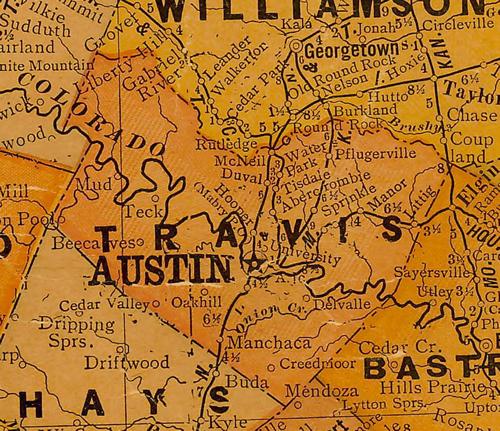Duval, Texas, Travis County. (original) (raw)
History in a Pecan Shell
Now primarily known as an exit of Hwy 183, North Austin�s Duval Road once connected Austin to the farming community of Duval. Settled in 1875, it became a stop on the IG&N railroad and was named for store owner Douglas Duval.
The importance of a railroad connection added weight to the community and two years later, the smaller community of Mount Juliet gave up its postal connection � allowing their post office to be moved to Duval. The population of Duval in the mid 1880s was 75 residents � served by three stores. The town �exported� stone and cedar � two items that seem to be an inexhaustible resource in this part of Texas.
In 1890 the population had fallen to a mere 50 people and then to just 35 at the close of the 19th century. The post office shut its doors and mail was routed through McNeil in 1902. The nearly forgotten town was annexed by Austin in the mid-1970s.
Footnote in Duval's History
The more personal history of Duval that follows was researched by Anna Galloway of Austin who suggested Duval be included in our town pages. --Editor "I was born in Brackenridge Hospital, Austin and my parents lived on a farm that was the location of the former town of Duval, Texas.
It was located adjacent to the� IGN railroad where it formerly crossed Duval Road in what is now North Austin.�East part of Angus Valley subdivision and all of the Champions Forest subdivision. At the entrance to Champions Forest, Whispering Valley Road passes over where the Mercantile Store stood.
�My father lived in [nearby] Merrilltown, Texas... the family home stood where the water tank is currently located to the west of Mopac toll-road. [He] and his dad saw the smoke from a fire at Duval. He saddled up horses for himself and 2 or 3 sons and took tools to fight the fire.� My dad said they were too late as the Merchantile Store was the building that started the fire.�A strong wind had blown embers to the roof of each house in the small town.� All houses burned except one and it was later moved south of its former location. The buildings owned by the railroad did not burn nor did the depot and the post office.� There were five other houses located on small farms that did not burn.� The depot was closed and moved in the late 1920's or early 1930's.� Post Office closed as well." - Anna Galloway
Watters Park is another town in the vicinity that exists only in name. Ms Galloway writes: �The spelling on the exit sign on Mopac near the toll road part of Mopac has the name misspelled as �Waters Park.� As of this writing, we�re unable to find any history for Watters, Texas. - Ed
Texas Escapes, in its purpose to preserve historic, endangered and vanishing Texas, asks that anyone wishing to share their local history, stories, landmarks and recent or vintage photos, please contact us.
